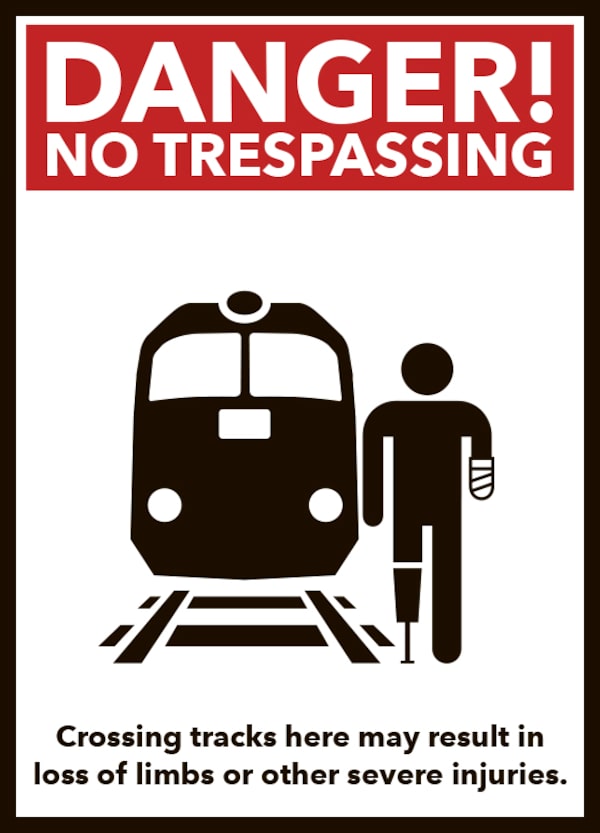Signage for the Mental Health Hotline at the Port Credit Go Station on Nov. 15, 2019.Tijana Martin/The Globe and Mail
Every year, on his birthday, the man would sneak onto one of the GO Transit tracks and wait for a train. Each time, transit security got an alert and brought him to safety. Until the year they didn’t get there in time.
That man was one of 90 people to die by suicide on Ontario’s GO network so far this decade, a grim tally that has accelerated dramatically this year for reasons no one can explain.
There have been 17 deaths by suicide on GO tracks so far in 2019. With six weeks left in the year, that toll is already more than twice as high as the annual average for the rest of the decade, and half again higher than the next worst year.
The unusual suicide toll is highlighting the need to stop unauthorized people on the tracks – a category of behaviour that includes not only access by distressed individuals, but also those short-cutting across or walking their dogs. And it is putting pressure on an internal group established this spring by Metrolinx, the regional transit agency, that is working on new ways to prevent rail suicide and deal with its fallout.
“As we see more [incidents] and as we see more families affected, more individuals affected, more of our staff affected, more of our passengers affected, it does create more urgency,” said George Bell, the Metrolinx vice-president of safety and security who established the new working group.
“Our mantra is, ‘Everyone home safe, every day.’ And by that we mean everyone. People who are at risk of accidental injury or intentional injury, we want everyone to go home safe.”
While suicide by any means can leave families and friends grieving, using a train as the method can have a broader effect.
Reuven Jhirad, a deputy chief coroner in Ontario, told a recent conference on rail suicide that train crews involved in these incidents are forced to assume multiple roles. At once, they are victims, witnesses, inadvertent participants and potentially first responders.
When the suicide happens at a station, people on the platform may be traumatized by what they have experienced. Investigations into the deaths can take hours and wreak havoc on rail operations, while passengers trapped on the immobilized train feel the weight of what has happened.
“[The staffer] made the announcement and the train went silent,” said Joe Nethery, a passenger who was stranded more than three hours last year on a Via train that fatally struck a suicidal person on a GO track. “All I could think about was there’s a family out there really suffering that night.”
While Metrolinx is still fleshing out its anti-suicide strategy, ideas range from the technological – such as pinging the phone of a person lingering near the tracks with an anti-suicide message – to the more conventional, including better support for staff involved in these incidents and anti-trespass mats.
Elisabeth Santo demonstrates the difficulty of balancing on the anti-trespass panels installed by Metrolinx, near the Port Credit Go Station on Nov. 15, 2019.Tijana Martin/The Globe and Mail
One of these mats is near the Port Credit GO station, an area marked by the frequency of passing trains, the number of people cutting across and a suicide nearby. Installed on either side of the level crossing, the rubber mats are a sort of human cattle grate, with a spiky surface making it hard to walk into the rail corridor from the road.
Metrolinx is aiming to install these by next year at all crossings on the Lakeshore East and West lines, which are the agency’s highest frequency routes and also the ones that experience the most suicides.
Other ideas may prove harder to pursue. One proposal is to use artificial intelligence to monitor video footage, looking for behaviour that could indicate suicidal thoughts. However, intentional fatalities on the GO network typically happen away from stations, and it’s not clear help could arrive in time if a potential victim was identified.
While suicide by train is as old as the railway industry, attitudes have changed in recent years. Where once staff involved in an incident were expected to be back at work the next day, mental-health support and time to recover is now common.
Communication with the public around suicide has also changed. A few years ago, Metrolinx became more open about discussing these incidents publicly, and worked toward less judgmental language for describing them.
The national not-for-profit Operation Lifesaver, funded by the rail industry and Transport Canada and geared at helping prevent accidental death on the tracks, has also started to adapt its message. A campaign targeted at suicidal people is being crafted, for possible roll out next year. New warning signs telling people that being hit by a train may lead to serious injury but not necessarily death are already being installed in places.

A new warning sign from Operation Lifesaver, an industry group trying to reduce fatalities around railway tracks, highlights that being hit by a train is not necessarily a sure death.Courtesy of manufacturer
Mr. Bell, who is retiring soon, is being succeeded by someone with experience in anti-rail-suicide campaigns.
Martin Gallagher, the newly minted chief safety officer at Metrolinx, said the agency needs to pursue tactics that keep people away from the trains. But he also wants deeper analysis of who is choosing to die on the GO tracks, potentially leading to tailored public messaging.
He pointed to Britain, where he was part of a campaign that he said coincided with a 12-per-cent drop in the number of rail suicides. He explained that they learned victims were 80-per-cent male, leading to messaging encouraging men to be more open with their professional or personal problems.
“These people aren’t being selfish and not worried about delaying commuters,” Mr. Gallagher said. “It’s a serious mental-health issue.”
 Oliver Moore
Oliver Moore